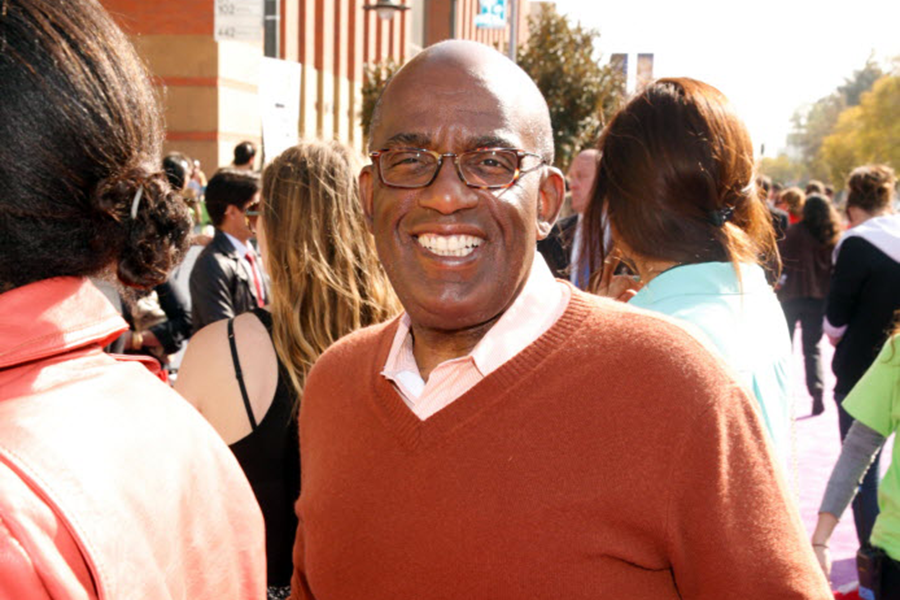Al Roker's #Rokerthon: Constructive fundraiser or 'slacktivism'?
Loading...
At about 10:45 on Thursday morning, the Today Show’s Al Roker called out for a green tea as he stared at his phone. Canada’s “futurecast” forecast sat still on the screen behind him. He was nearly 13 hours into his 34-hour live weather report broadcast, which aims to break the Guinness Book of World Record for longest uninterrupted live weather report broadcast.
Behind him, where onlookers waved toward the camera, a sign saying #rokerthon sat in the window.
“How’s our trending going?” he asks. “To me, 13,000 doesn’t seem like a lot of tweets.”
Soon, he snapped back into action, calling Calgary’s forecast “bikini weather” and smiling at the camera. He capped off the 13th hour with a selfie, which he tweeted by 11:10 a.m.
Mr. Roker’s broadcast aims to raise money for the United States Service Organizations (USO), which helps troops during their deployments. As of press time, his campaign had raised more than $30,000.
Charity groups around the world are participating in Thursday’s Guinness World Records Day, which historically has seen very public stunts that aim to break records.
Richard House, a children’s hospice in London, gathered 373 people dressed as penguins, breaking the hospice’s former record, set last year, of 325. BBC Gloucestershire in England aimed to beat the longest line of cakes world record (607 meters) for the charity BBC Children in Need.
But with Roker’s celebrity guests, such as Nick Lachey and Ed Schultz, and the ticking clock below the screen, coverage of his high-profile stunt may come across more like self-promotion than a genuine fund-raising effort. The trend aligns with other big-name promotions, like the ALS Ice Bucket Challenge or No-Shave November, during which men do not shave to raise awareness for cancer research.
Over the summer, bloggers and commenters picked apart the Ice Bucket Challenge, when celebrities, politicians, and thousands of others raised more than a million dollars in two weeks to fight Lou Gehreg’s disease. Many participants filmed themselves dumping a bucket of ice water over their heads and posted the clip online.
The challenge was tremendously effective, raising over $100 million in the US. Barbara Newhouse, the president of the ALS association, told the Boston Globe in August that she had "never seen anything like this in the history of the disease."
"We couldn’t be more thrilled with the level of compassion, generosity, and sense of humor that people are exhibiting as they take part in this viral initiative," she said.
In an August piece for Vice, editorial assistant Arielle Pardes called the Ice Bucket Challenge “basically narcissism masked as altruism.” She compared the phenomenon to Livestrong Bracelets that raised money to cancer and the red equal sign to support gay marriage that many posted to social media outlets.
“It’s trendy to pretend that we care, but eventually, those trends fade away,” she wrote in Vice.
In an email to the Monitor, Ms. Pardes said that while raising money for charity is a worthy cause — and that she was thrilled that so much money was donated — problems arise when stunts distract from the cause.
“When the stunt becomes its own thing, separate from the cause (which, in my opinion, was the case with the Ice Bucket Challenge) then you aren’t effectively motivating charitable donations, and then what’s the point?” she wrote.
In a Nov. 11 piece on “slactivism” — the slacker’s activism” — Scott Gilmore, of Maclean’s, criticized these high-profile efforts as selfish. “If you want to help, just give money or time. Anything else is only about you,” he wrote.
And in recent years, charities have started pushing back, asking for donations as well as public support. UNICEF took a stand in 2013 with a video ad campaign.
“Like us on Facebook, and we will vaccinate zero children against polio,” the posters read, urging readers to buy polio vaccine for 4 Euro to save the lives of a dozen children. “We have nothing against likes, but vaccine costs money.”
By 12:45 p.m., Roker wore a white Channel Five baseball cap. As the southern plains weather forecast was on the screen, he restated the purpose of the marathon. USO, he said, takes care of troops here and abroad. He waved at onlookers outside and leaned back in his chair. After a pause, he gave the forecast for Abilene, Texas — clear skies with dropping temperatures.






